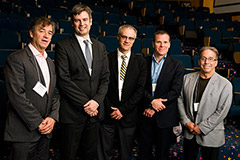Fostering innovation
By Betty Zou
How do we create an environment that allows medical device startups to thrive?
That question formed the basis for the third annual Schulich Innovation Research Day hosted by Sunnybrook Research Institute (SRI) and York University. The event, held June 15, 2015, at Sunnybrook, drew more than 300 participants from research, clinical, engineering and business realms.
In his welcoming remarks, Dr. Michael Julius, vice-president of research at SRI and Sunnybrook, commented on the seamless integration of research at SRI with the clinical domain at Sunnybrook. “Discovery to clinical impact through the medical marketplace is high cost and high risk,” he said. “The need for private sector partners is fundamental to everything we do here.”
Dr. Graham Wright, director of the Schulich Heart Research Program at SRI, provided an overview of the day. “Today we’re going to explore the challenge of getting the environment necessary to encourage effective startups [and] to make sure that startups succeed in today’s climate,” he said.
The event comprised three sessions, each of which addressed a unique element of the startup ecosystem.
The first, on the medical device design landscape, began with a keynote lecture by Scott Phillips, president of StarFish Medical, a medical device design company based in Victoria, B.C. He spoke about the state of innovation in the Canadian medical device industry and how to become a medical device entrepreneur. Although Canada was initially slow to embrace the medical device sector, Phillips noted that within the past five years, the number of medical device patents registered to Canadian entities grew from about 100 each year between 2005 and 2009 to nearly 400 per year from 2010 to now.
The second session focused on gaps in the medical technology industry and featured two speakers. The first was SRI alumnus Cameron Piron, president of Synaptive Medical. As a master’s student at SRI, Piron came up with the idea of a breast magnetic resonance imaging biopsy system that led to the formation of Sentinelle Medical, an SRI spin-off company where he served as CEO before it was sold for almost $100 million in 2010. He talked about the different strategies he used in running each company.
Dr. Adnan Siddiqui, director of the Gates Vascular Institute, gave the second keynote presentation. He spoke about the need for interdisciplinary and international collaborations. He also highlighted the importance of partnering with industry and adapting to shifting markets and financing strategies.
In the final session, Dr Chaim Lotan from the Heart Institute of the Hadassah University Medical Centre and Dr. Fumi Ikeno from the Stanford Biodesign Program shared their insights from establishing biodesign programs at universities in Israel and Japan. These programs challenge groups of students from diverse backgrounds to develop a medical innovation. Students participate in all stages of device development and commercialization, from identifying a need and designing a solution, to writing a business plan and obtaining financial support.
The day ended with a competition in which teams were tasked with identifying a real clinical challenge and devising a solution for that challenge. Each team consisted of a clinical fellow, an MBA student and an engineering student, and was given the opportunity to shadow a physician at Sunnybrook to identify a clinical need. The first team presented their plan for a new guide wire system to treat patients with chronic total occlusions, while the second team addressed the risk of embolization and stroke after transcatheter aortic valve implantation. The excellent efforts of both teams resulted in a tie for first place.
Wright concluded the event by thanking the organizers and participants. He also reminded everyone to pick up a copy of the 2015 SRI Magazine that was launched earlier in the day, and that is dedicated to innovation in heart research at SRI.













